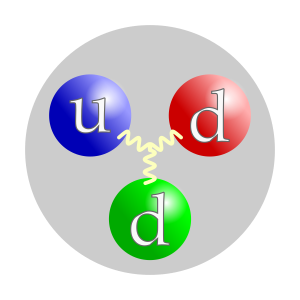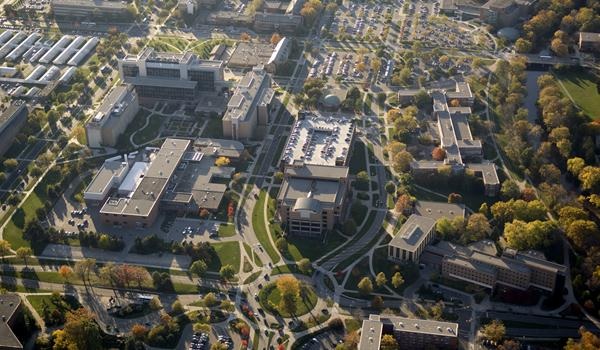From The Facility for Rare Isotope Beams [FRIB]
At
6.19.24
Eric Gedenk

Theoretical physicists and experimentalists worked together to measure the mass of a rare isotope expected to form a rare proton halo, publishing the first results from FRIB’s Precision Measurement Program. (Graphic courtesy of FRIB)
In May 2022, the Facility for Rare Isotope Beams at Michigan State University, launched its precision measurement program. Staff from FRIB’s Low Energy Beam and Ion Trap facility take high-energy, rare-isotope beams generated at FRIB and cool them to a lower energy state. Afterward, the researchers measure specific particles’ masses at high precision.
The LEBIT team, led by Ryan Ringle, adjunct professor of physics at FRIB and in the MSU Department of Physics and Astronomy and senior scientist at FRIB, and Georg Bollen, University Distinguished Professor of Physics and FRIB Experimental Systems Division director, recently published a research paper that used the facility to take a step in verifying the mass of aluminum-22. Researchers think this exotic isotope demonstrates a rare but interesting property—specifically, that the nucleus is surrounded by a “halo” of protons that loosely orbit the nucleus. This halo structure reveals distinctive physical properties during its fleeting existence.
“This program requires a lot of extra beam preparation to perform experiments, and this is the first measurement in FRIB’s science program,” Ringle said. “This measurement could not have been done in a reasonable time at FRIB’s predecessor, the National Superconducting Cyclotron Laboratory, and it highlights our facility’s potential moving forward. Considering this was done with one-eightieth of FRIB’s power specification, this was like a warm-up before exercising.”
The team published its results in Physical Review Letters.
Capturing elusive proton halos
While most atoms have electrons tightly orbiting the nucleus, protons and neutrons are part of the nucleus itself.


However, when atoms encounter many of the same charged particles under certain conditions, they can create halos that orbit the nucleus beyond the pull of the strong nuclear force—the force that would normally keep these particles within the nucleus. While all halo structures are rare fleeting phenomena, neutrons are usually observed as halo particles. A nucleus’s positive charge usually repels protons’ positive charges, meaning that halos made of protons are even rarer. Measurements on nearby isotopes suggested that aluminum-22 might be an isotope that could form a proton halo, but researchers needed to verify this directly in other experiments.
To achieve this, the team creates a high-energy isotope beam of aluminum-22 using a process called “projectile fragmentation” at FRIB. The researchers create a beam from a heavy, stable atomic nucleus of a given element—in this case, an isotope of argon—then accelerate the beam to half the speed of light. The beam then hits a target with these ultra-fast-moving particle projectiles. This violent collision creates rare, short-lived isotopes that the researchers can shepherd into an instrument to filter out the particle of interest. They then lower the temperature to slow them down into a uniform beam and measure particle mass accurately.
While the team was able to accurately measure the mass of aluminum-22, it is only part of verifying the isotope’s proton halo structure. The LEBIT researchers’ colleagues in the Beam Cooler and Laser Spectroscopy (BECOLA) facility at FRIB now plan to take the next step in verifying the proton halo by measuring the charge radius—the distribution of protons around the nucleus—as well as how much the nucleus may be deformed from its traditional, spherical shape. Taken together, these measurements can unequivocally confirm the existence of a proton halo structure around aluminum-22.
Ringle pointed out that the collaboration between theoretical physicists and experimentalists at FRIB plays an essential role for research like determining the existence of a proton halo around a rare isotope such as aluminum-22.
FRIB provides research opportunities to graduate students
Ringle credited students on the team for playing a key role in advancing this research. One of LEBIT’s graduate students, Scott Campbell, took this project on as part of his dissertation.
“He really took charge of running this experiment from start to finish,” Ringle said. “The students who work with us really benefit from the wealth of expertise we have at this facility. Nowhere else is a facility like this located in the middle of a university campus. It allows students to come in for an hour or two between their classes or before they go home for the day. They can work at the lab part-time and easily pair that with taking classes. But our facility gets benefit as well; we have increased access to talented, motivated students.”
Campbell studied physics and computer science at Gonzaga University as an undergraduate. He was excited by the prospect of coming to MSU for graduate school in large part to FRIB being on campus and being a major resource for physics students. “I was very excited by the prospect of doing for nuclear physics research at MSU, especially with FRIB ramping up during my studies,” he said. “We have access to these great facilities and a great community, and we get to participate in groundbreaking advances in nuclear science.”
Campbell also noted that FRIB not only offers world-class facilities, but also networking opportunities and mentors like Ringle. “We are surrounded by colleagues who are interested in your research and want to help you push science forward,” he said.
See the full article here .
Comments are invited and will be appreciated, especially if the reader finds any errors which I can correct.

five-ways-keep-your-child-safe-school-shootings
Please help promote STEM in your local schools.
![]()
Stem Education Coalition
Facility for Rare Isotope Beams


The Facility for Rare Isotopes Beams (FRIB) is a scientific user facility for nuclear science, funded by the U.S. Department of Energy Office of Science (DOE-SC), Michigan State University, and the State of Michigan. Michigan State University contributed an additional $212 million in various ways, including the land. MSU established and operates FRIB as a user facility for the Office of Nuclear Physics in the U.S. Department of Energy Office of Science. At FRIB, scientists research the properties of rare isotopes to advance knowledge in the areas of nuclear physics, nuclear astrophysics, fundamental interactions of nuclei, and real-world applications of rare isotopes. Construction of the FRIB conventional facilities began in spring 2014 and was completed in 2017. Technical construction started in the fall of 2014 and was completed in January 2022. The total project cost was $730M with project completion in June 2022.

On 11–12 July 2018, the Facility for Rare Isotope Beams accelerated first beam in three of forty-six superconducting cryomodules (painted green). Beam in the warm radio-frequency quadrupole was previously accelerated in September 2017.
The FRIB cryogenic plant made its first liquid helium at 4.5 kelvin (K) on 16 November 2017. Photo courtesy of MSU Communications and Brand Strategy.
FRIB will provide researchers with the technical capabilities to study the properties of rare isotopes (that is, short-lived atomic nuclei not normally found on Earth). Real-world applications of the research include materials science, nuclear medicine, and the fundamental understanding of nuclear material important to nuclear weapons stockpile stewardship. More than 20 working groups specializing in experimental equipment and scientific topics have been organized through the FRIB Users Organization.
The FRIB is capable of expanding the known Chart of the Nuclides from some approximately 3000 identified isotopes to over 6000 potentially identifiable isotopes. It accelerates beams of known isotopes through a matrix which will disrupt the nuclei, forming a variety of unusual isotopes of short half-life. These are ‘filtered’ by directing away the wrong charge/mass isotopes by magnetic field, leaving a small beam of the desired novel isotope for study. Such beam can also target other known isotopes, fusing with the target, to create still further unknown isotopes, for further study. This allows expansion of the Chart of the Nuclides towards its outer sides, the so-called Nuclear drip line. It also allows expansion of the Chart towards heavier isotopes, towards the Island of stability and beyond.
The establishment of a Facility for Rare Isotope Beams (FRIB) was the first recommendation in the 2012 National Academies Decadal Study of Nuclear Physics: Exploring the Heart of the Matter. The priority for completion was listed in the 2015 Long Range Plan for Nuclear Science: Implementing Reaching for the Horizon by the DOE/NSF Nuclear Science Advisory Committee.
The facility has a robust Health Physics program under the umbrella of the university’s Environmental Health and Safety department.
The Michigan State University is a public research university located in East Lansing, Michigan. Michigan State University was founded in 1855 and became the nation’s first land-grant institution under the Morrill Act of 1862, serving as a model for future land-grant universities.
The university was founded as the Agricultural College of the State of Michigan, one of the country’s first institutions of higher education to teach scientific agriculture. After the introduction of the Morrill Act, the college became coeducational and expanded its curriculum beyond agriculture. Today, Michigan State University is one of the largest universities in the United States (in terms of enrollment) and has approximately 640,000 living alumni worldwide.
U.S. News & World Report ranks its graduate programs very high in the U.S. in elementary teacher’s education, secondary teacher’s education, industrial and organizational psychology, rehabilitation counseling, African history, supply chain logistics and nuclear physics. Michigan State University pioneered the studies of packaging, hospitality business, supply chain management, and communication sciences. Michigan State University is a member of the Association of American Universities and is classified among “R1: Doctoral Universities – Very high research activity”. The university’s campus houses the National Superconducting Cyclotron Laboratory, the W. J. Beal Botanical Garden, the Abrams Planetarium, the Wharton Center for Performing Arts, the Eli and Edythe Broad Art Museum, the Facility for Rare Isotope Beams, and the country’s largest residence hall system.
Research
The university has a long history of academic research and innovation. In 1877, botany professor William J. Beal performed the first documented genetic crosses to produce hybrid corn, which led to increased yields. Michigan State University dairy professor G. Malcolm Trout improved the process for the homogenization of milk in the 1930s, making it more commercially viable. In the 1960s, Michigan State University scientists developed cisplatin, a leading cancer fighting drug, and followed that work with the derivative, carboplatin. Albert Fert, an Adjunct professor at Michigan State University, was awarded the 2007 Nobel Prize in Physics together with Peter Grünberg.
Today Michigan State University continues its research with facilities such as the Department of Energy -sponsored Plant Research Laboratory and a particle accelerator called the National Superconducting Cyclotron Laboratory [below].
The Department of Energy Office of Science named Michigan State University as the site for the Facility for Rare Isotope Beams (FRIB). The $730 million facility attracts top researchers from around the world to conduct experiments in basic nuclear science, astrophysics, and applications of isotopes to other fields.
In 2004, scientists at the Cyclotron produced and observed a new isotope of the element germanium, called Ge-60 In that same year, Michigan State University, in consortium with the University of North Carolina at Chapel Hill and the government of Brazil, broke ground on the 4.1-meter Southern Astrophysical Research Telescope (SOAR) in the Andes Mountains of Chile.

The consortium telescope will allow the Physics & Astronomy department to study galaxy formation and origins. Since 1999, Michigan State University has been part of a consortium called the Michigan Life Sciences Corridor, which aims to develop biotechnology research in the State of Michigan. Finally, the College of Communication Arts and Sciences’ Quello Center researches issues of information and communication management.

The Michigan State University Spartans compete in the NCAA Division I Big Ten Conference. Michigan State Spartans football won the Rose Bowl Game in 1954, 1956, 1988 and 2014, and the university claims a total of six national football championships. Spartans’ men’s basketball won the NCAA National Championship in 1979 and 2000 and has attained the Final Four eight times since the 1998–1999 season. Spartans ice hockey won NCAA national titles in 1966, 1986 and 2007. The women’s cross-country team was named Big Ten champions in 2019. In the fall of 2019, MSU student-athletes posted all-time highs for graduation success rates and federal graduation rates, according to NCAA statistics.




